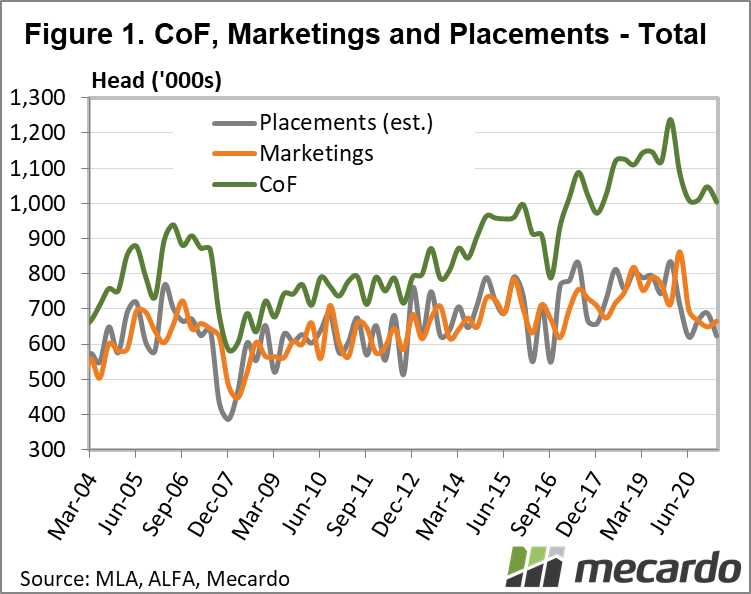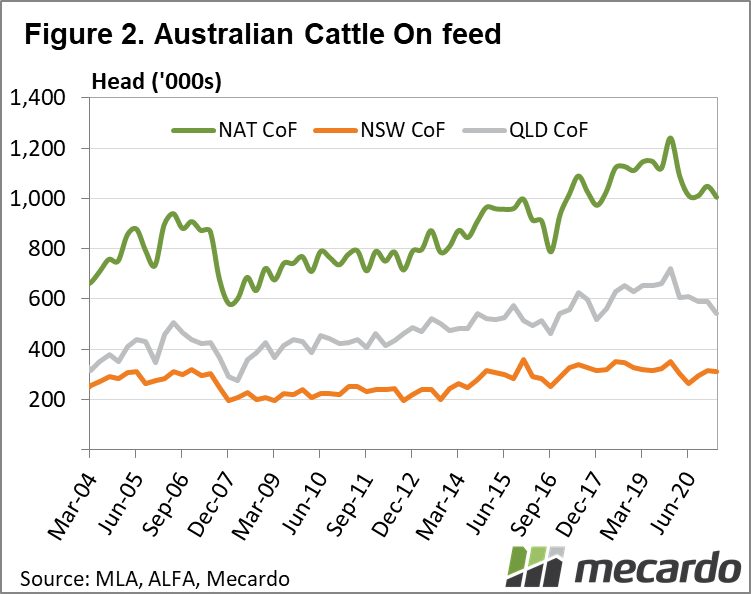The latest cattle on feed data is in, and numbers dipped for the first three months of 2021 by 4 per cent. Feedlot numbers did remain above the 1 million head mark, however, and two states increased their numbers on feed in the January to March period, being Western Australia and Victoria.
While feeder steer prices rose for the quarter, both from the previous quarter and year-on-year, so to did grainfed over-the-hook returns, supporting lotfeeder margins enough to stop any substantial drop in feeding. Marketings also rose, as grainfed cattle supported processor supply that wasn’t flowing from the paddock.
Cattle on feed numbers were 1,005,035 head for January to March, which was 8% less than the same quarter in 2020. South Australia had the biggest percentage decrease, with 13.5% less cattle on feed compared to the previous quarter, but it was Queensland that had the largest drop in actual numbers, with more than 46,000 less cattle on feed than the three months to December. WA on the other hand gained 22.6%, and Victoria 1.4% (albeit that actual number figure was just 778 head).
On the marketings front (feedlot turnoff), they rose by 2.5% from the previous quarter, but were down significantly year-on-year, falling 33% or by nearly 200,000 head. We have to keep in mind total slaughter though when looking at these figures, which hit a 20-year-low for the March quarter. Marketings in all states were lower year-on-year, except for NSW, with Queensland making up a majority of the fall, losing 36 per cent compared to the March 2020 quarter.
Price-wise, according to Meat & Livestock Australia and the Australian Lotfeeders Association, the national feeder steer indicator averaged 446ȼ/kg live weight for the quarter, a rise of 27ȼ year on year. In the eastern states, the paddock feeder steer indicator (280-350kg) averaged 460ȼ/kg (to March 19, the latest data available). This was up from 422ȼ/kg in the December quarter, and a jump of 129ȼ/kg year-on-year, with the average in March 2020 sitting at 331ȼ/kg.
Prices also rose on the other end however, with the Queensland over-the-hook 100-day grainfed steer indicator averaging a record quarterly price of 677ȼ/kg cwt, up 10ȼ/kg on the previous quarter and more than 50ȼ/kg year-on-year.
What does it mean?
With slaughter dropping to 20-year lows, but competition heating up in our export markets due in part to our ongoing high domestic prices, the lotfeeder sector remains crucial to ensuring processor supply, which has helped push grainfed prices to where they are. If feeder supply doesn’t push those prices down, grainfed returns will have to stay at record highs to keep numbers on feed above 1 million.
Have any questions or comments?
Key Points
- Cattle of feed numbers dropped 4 per cent in the January to March quarter but remain over 1 million head.
- Marketings increased from December 2020, but saw a significant drop year-on-year, in line with lower slaughter across the board.
- Eastern states paddock feeder price climbed higher for the first quarter, as did the Queensland OTH 100-day grainfed steer indicator.
Click to expand
Click to expand
Data sources: MLA, Mecardo














